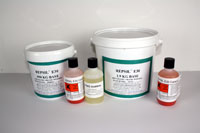Silicone RTV Rubber
Silicone RTV Rubber
This page is about Silicone RTV check out the main project index for the rest.
Silicone RTV rubber is a man made material which is typically used for mould making, although high quality Silicones are available for prosthetic use. Silicone is either a base with a catalyst, or a part A-B mixture, which sets to solid rubber in a variety of cure times. This article discusses some products and example projects.
I’ve used a lot of Silicone RTV moulding rubber over the last two years in my Iron Man suit project. Silicone is great for mould making because it sets with a catalyst so it can cure in thick sections, and it doesn’t stick to anything much besides itself.
The ‘RTV’ on the end of ‘Silicone RTV’ stands for Room Temperature Vulcanizing, this means it will cure at room temperature. Silicone RTV comes in various types and firmnesses which are measured on the Shore Hardness Scale. I have been using a UK product called Repsil E30, pictured below, which is a ShoreA30 Silicone. This means it is a fairly firm general purpose Silicone. Repsil is a Tin Cure, also called Condensation Cure Silicone. It has a large amount of base Silicone product and a small amount of catalyst, which is added at 5-10%.
Tin cure Silicones are generally the cheapest mould making Silicones, and are good for short runs of casts etc. Silicone rubber does not stretch of shrink as it cures, so you can get excellent mould reproduction provided you make the mould thick enough to support itself, or in some cases use a rigid mother mould.
The simplest form of mould is a box mould. This involves placing the original item to be moulded in the bottom of a box and pouring silicone on top of it, waiting for it to cure, and demoulding. The mould can then be used to pour resin in to make a cast.
Repsil E30 is also available with a thickener additive so that you can spread the Silicone onto the object like butter, without it running away. However, generally it’s best to use an unthickened coat of Silicone first to pick up surface detail and avoid bubbles. I have used this process a lot to make all of my Iron Man moulds. Here is a YouTube video of me spreading Silicone RTV onto a leg piece:
Platinum Cure, also called Addition Cure Silicones are supplied as equal part A-B liquids. Platinium Cure Silicones are generally harder wearing for long runs of casts, and also come in a large variety of properties for prosthetic use as well as moulding. Smooth-on Dragon Skin for instance is very stretchy, for making animatronic or prosthetic pieces.
Some Silicones are sensitive to chemicals such as Sulphur, and also latex, so all mixing containers and sticks should be clean prior to use with Silicone.









